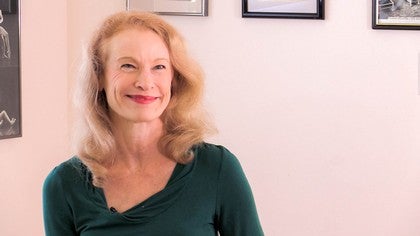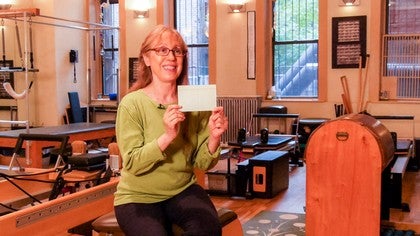Description
About This Video
Transcript
Read Full Transcript
My name is Carrie Roland and I came up from Miami to a dance in New York, like most dancers. And, uh, I auditioned at the Joffrey Harkness and New York city ballet and ballet theater and I got scholarships all four. And I chose Harkness and I began to dance there in the school and dance with the heart and the shoes company and, um, hopefully to get into the larger company, which unfortunately in 1975 went belly up. So, um, after that I moved up to a heart for, for a short period of time and then back to Miami. Then I danced the fusion dance company and was the ballet master and a choreographer there for two years. I came back to New York and when I came back to New York, I danced with, uh, with the, the gloves ski, ballet, Fred Benjamin, uh, uh, Fred Benjamin's a dance company and taught at Alvin Ailey's, taught ballet there for three years. And, uh, then I started having problems with my ankle and I had to have surgery to remove bone spurs. And my doctor, um, my orthopedist, uh, uh, William Liebler sent me to Corollas for rehabilitation on my ankle.
Dr Leber set me there. Um, I believe it was in 76 or 77 when I had my, um, surgery on my ankle. And I didn't know that it was politeness, but I, he told me to go to this woman named Corolla Treer who worked with a lot of dancers and she was wonderful with dancers and she would fix my ankle. And, and that's how I ended up with Corolla. The first thing the Corolla, um, did with me was to put me in front of a mirror and she very specifically talked about placement alignment and proper posture and, uh, that in this swing five years, I saw her do that with everyone and she was rather amazing and that she would be able to look at somebody's postural complex and basically pinpoint what they were doing wrong, how their foot placement was wrong, where their hips aligned over their knees and this and that. And, uh, this is a learning experience even as a dancer and gymnast. I found that how her, her take on, um, how the body should just sort of stand at rest was completely something I'd never heard of before. I didn't not understand her concepts, but I was, I found it rather enthralling. And uh, so soon after that she began to with me and put me on the reformer and began to torture me as I had to go through this very uncomfortable and painful process of rehabilitating my ankle post-surgery. So that was the beginning of our relationship when specifically the reformer and co approa Corolla had three in a row. And when you're there and you've got her pulling your ankle or adjusting your hip or whatever she was doing with you, you were aware of other people going through their particular, you know, uh, routines. Uh, she always had two other assistants working at the same time.
And if you had a two or three on the reformer and then you had other people on either the, the, the foot machine or it was a busy place. So there was a lot going on. So you're definitely aware that there was a lot of commotion, but your focus of course, was your own work crawl. I had an uncanny sense, I think of of the most minute part of the body mechanics. She really had this innate sense of what was wrong or what needed to be worked on. And she also had this very powerful, I would almost say aggressive manner. And it was, you do it like this and that's it. And you did it.
She was as little tiny thing, maybe not even a hundred pounds, but she was a powerful woman. First of all, dr Liebler suggest that they go to Corolla tree or I wasn't, I didn't realize that Corolla was a German for Carol. I didn't realize it was even a, she really, and I had not really heard of [inaudible]. So, um, the whole experience was new. And to see this, this little woman who talks about, who talked often about being in the French and caps, uh, and the Nazi days before she got into Baltimore and she survived, uh, she told stories of doing contortionist on rollerblades to entertain Nazis. And that's how she stayed alive. Well, somebody that has that kind of survival instinct and is, you know, out there and, and repaired her own back with the plotters technique, somebody to be admired. The studio was very, very structured. It was very organized from the minute you walked in. If you were five minutes late, Corolla would bark out mr who owns whatever it was.
You're late door, five minutes late, you know, hurry up and that person, sometimes a wall street executive would dash in that dressing room and dashed out of there in three minutes flat apologizing profusely for being, you know, five minutes late. So, um, and it was incredibly clean. Um, she was a stickler for the, uh, the apparatus to always be just absolutely pristine. After about six months there, and I really had finished my, my rehabilitation with my foot pretty much, and I was getting a much better condition, runs back to class and she had an assistant who came up to her and said, Corolla, I'm going to move back to Boston and I'm giving you two weeks notice. And Corolla had a bit of a meltdown. How could you do this to me? How can I heard it? And I jumped off the apparatus of the performer and I said, I would love to learn this. I would love to work in this field.
And she at first said, no, mr Roland, you still are dancing professionally is not good for me in a, and I said, well, yes, but I think I can make it work. I said, as long as I can adjust my hours if I have rehearsals or performances. And she said, well, I'll tell you why. I'll train you for three months and if you work out, no pay. If you work out you have a job. So I did that and after three months she said it was very good.
She was thrilled with my work and I ended up working there for five years. So I just happened to be in the right place at the right time. The three month period that I was being trained by Corolla was extremely difficult because if I was working with someone and she was instructing me how to work with anybody, B, they had a torn meniscus or if they had a hip flexor problem or whatever their issue was, if I wasn't doing everything perfectly to her in two to her way of doing something, she really let you have it. And she would um, really lay on the carpet in front of anybody. She didn't, she didn't worry about your feelings or that person. She just, you know, she really wanted, she was a perfectionist so it was difficult. But I learned a lot. I would watch Corolla work with someone. She would place their feet on the foot bar or whatever she was doing, the spinal exercises or anything and I would have to stand right next to her and I would ask questions and she would then, uh, you're doing this because of this and we do this because of this. And um, so it was really watching. And then once she, I think, felt that I sort of knew some basics, she would then step back and she would always look over her, over her shoulder and watch everything I did.
And she was like that with other instructors who came on while I was working there. I did learn a lot from Francisco monsoon and Frank who we all called, uh, Frank, uh, was the principal dancer with the New York city ballet from the 30s. And Frank was, and one of the most amazing people I've ever met in my life. He had worked with Joe Paladino himself and often told stories of Joe and his wife, Clara. And, uh, Frank was able to actually take my body further and uh, helped me learn even more, uh, while I was here because he was a mainstay. He was there almost every day and he would just come in and, uh, do his, his thing. And he would often come over to me and say, we'll do this and try this.
And if I was having maybe some difficulties with somebody, uh, trying to get them to do certain things, he would come over and say, well, try and doing this and move Alyssa. And sometimes Corolla didn't like it. Uh, but some, but then other times she would just let it go. So you never knew how she was going to react to Frank sort of, uh, becoming another guru for me, I often thought of Corolla is a German mighty mouse. This, she was this little thing that, for an example, uh, I remember once I was doing my, my ankle work that she instructed me and I was sort of doing my own thing and all of a sudden she saw something that she didn't like that some other, uh, sister her or instructor was doing with somebody and she suddenly jumped off from her desk, like from a catapult and sportive loft it and ran over to the apparatus and move the person's foot half an inch and said, that is how you put the foot on art. I mean, just, it was like, what was that all about? A little frightening. There were several people that, uh, found Corolla abrasive, I should say, actually the abusive, she would lose your temper. And there were more than a few occasions when a grown man would leave there crying, go, go into the dressing room. Because I remember one example, there was a fellow who had surgery on his knee and Corolla wanted him to straighten the leg and he had problems straightening the leg and Corolla. Suddenly, this is about three weeks after knee surgery, not a replacement, it was a meniscus tear. He said, I said, spikes in your leg. And she slapped this guy's leg like this.
And he was in a state of shock and sort of jumped up and hobbled into the dressing room. And she followed him in there and he was in tears. And there were other people that this happened to. She did have sometimes a way about her that was not a, shall we say, conducive to a happy place. And another time there was a dancer from New York city ballet, Roger Worley who was on an apparatus and he was working in Corolla, came up and my back was sort of to him, but she also did something that give him a slap or something and uh, he jumped up and pinned her to the wall and said, Corolla, if you ever slap me again, I will throw you out this window. Well, that sort of took everyone's breath away.
But after that she treated him like he was the Prince of Siam. It was rather amazing transformation. When I saw this, uh, this event and other events and when people stood up to her, I said, okay, she's a bully. Once that that happened and she did something that I considered unpleasant to me, I changed our relationship by confronting her in a big way. And then it was wonderful. We socialize sometimes and I remember once my life, my parents and my sister were up visiting me and Corolla took us all to dinner down in that, I think it was Soho and Corolla really liked her.
Chivas Regal. And usually all the studio is open until six, usually about five o'clock she would disappear into her studio and where she lived. Uh, and she would, you know, have a drink but not that my family, we don't, we're not, we drink but socially, but, um, Corolla could drink anybody under the table and this little woman could put down double shots of Chivas Regal two, three, four and after one or two I'm wildly like to bumping into walls and she was like, nothing is, she really could. And I remember my sister after, I think one or two drinks, acrylic kept saying more and more we have Tamara bartender, you know, the waiter and basically the four of us were stumbling out. Oh, uh, barely able to get into a cab and find a way home. And Corolla was like, what's wrong with you? What's wrong? You people also a couple other times I would stay after to work when everybody left and I would stay after and do a session on my own. And every once in a while she would come out, well start naked and, uh, you know, open the door and say, mr Roland, I want you to know when I would look up and I would throw my head back because it wasn't really a site that I was thrilled to witness.
So that's what she was, she, she was a character. And then there was another time when the, when she had somebody was upset and they, they left and grow when they're to, uh, to discuss the problem. And this person was sitting on the toilet and Cruela came right in and sat a little shower area stall and just said, we have to talk about this. And this person said it was sitting on the toilet and she wouldn't leave the bathroom. I mean, it seemed to me that when I went to other Pilati studios in Manhattan here, uh, what I was seeing about leaving Corollas at one point, that everything about them, the layout, the quality of the equipment, the supervision, the, the teaching, uh, level, um, the, um, knowledge is I could discern it from the teachers, what they were saying, how they were handling people's bodies. And I thought, okay, um, I'm sticking with Corolla even though she was difficult at times. It was excellent. It was quality. And I found that the quality and her expertise were far surpassed.
Other people. And a couple friends of mine were working with other PyLadies teachers and I said to them, you know, you said that you've heard or some things I don't understand or agree with and I think you want to try Corolla. And they came there and they also said to me, they found the quality really top notch. Although they also thought she was difficult and sometimes very unpleasant. Corolla had several books and she would show me the books and uh, I would then say, read them or I would get my own copies. And I really became really sort of fascinated with the body and its mechanics and how it works and what went wrong with it. So, um, I really couldn't get enough of sort of learning.
And at one point I was asking her questions about something rather, and she suddenly put her hand in this and she looked up at me. She's mr Roland, I may teach you one, three, five, seven, nine but I'll never teach you two, four, six and eight 10. I thought, Whoa. I thought I, this was a little shocking and that was the beginning of the end because to me knowledge should be disseminated and freely given to everybody. And her attitude about that was I said, okay, she feels threatened by me. The other issues we started to have, there were things about the equipment that I didn't think were how they should be. I thought the foot bar was too high and she would often come over and push the chest down the ribcage down. And also anything that was done in front of the box with the neck, very, very, very pulled up and lengthened. And the more I read, the more I understood, I really maintained to this day that the C curve in the lumbar and the cervical region should be maintained and not flattened.
And I began to have on, I didn't averse have lower back problems and um, I was uh, dancing taking class with a wonderful, wonderful uh, but teacher who has taught at the Chichetti the system L Fredel Corvino and Alfredo said to me one day, he pulled me aside, he said, Carrie, you're beginning to have a problem with chest diminish. I said, what is that? And what it meant was, is I was planning to go into a jump. My chest would Cade down as I jumped, I would go into an arch. So I wasn't keeping myself vertical. And if you were doing a tour on layer or anything else, if you lose ever to Cal, you're going to go off your balance. So I began to sort of think, well, maybe doing all this pushing down with the rib cage and you know, is tore to taking me too far.
And I began to sort of buckle as I jumped. So I brought this up to Corolla and her response was, Joe palati said this and jog this and you know, she wouldn't hear of any other adjustment. So what amounted to, and if there are pictures of Corolla, if you see her from the side, she had no lower back. It was straight up and down. She lost the lumbar her back completely. And she was pretty much always the pain back pain. And um, so when I would bring this up that I never had back problems and my lower back was starting to bother me, she maintained it was from something else.
And I said, I don't think so. And one day I pointed out to her, I said, you know, [inaudible] most of what we're doing here, there's no lumbar except when we were doing the arches and we specifically working the back, the back is flat and to the point. And I think that weakens the back. And, um, I think there should be a small pillow or a towel underneath the lower back to maintain that lumbar curve just enough and the foot bar should be lowered so that it's more down below that the pelvis. And, um, because I said no one stands or walks with their feet, a foot in front of them. So we had this reoccurring conflict about this idea, these ideas. At one point Corolla said that she was, that I had been her best teacher and that she would like me to take over the studio. So I was at the time, quite flattered. And um, I said, well, okay. She said, I'm getting to be older. I'm 80 at some point or late seventies. And she said, so I'd like, you know, so I want you to know that I want you to stay and we have to talk about this.
Well, time went on and nothing was really said. So a couple of times I brought it up and so she said, okay, here's, here's what I suggest to you. And out of the blue, she said, you'll pay me $100,000 for the studio. And I'll stay on and teach and work here and live here and you pay me a a small, you know, salary in effect. And I thought, well, what's, what's the difference here? There's no difference. And then a friend, somebody I met at her studio, Gus lied, loft, looked at the figures and said, it's a sucker steel. You don't this. No, no, you don't want to do this. Also, what started to happen the last couple of years I was there, I began to have a reputation and doctors would start to tell people, there's this guy named Kerry Roland who works [inaudible]. You should work with him. People started calling up and say, you have someone there named Carrie Roland and I'd like to work and she would lose it. And that became quite a conflict because it was, this is nothing I asked for or wanted.
It just started to happen because I was good at what I was doing. When people started to call Corollas and ask for me and other people who were, had been going to Corollas, approached me in the hallway or would like slip me a note in the hallway, said, can you come to my house? I can't stand how she treats me or I can't stand. I got more and more people wanting me to, to work with them privately. So I began to do that and then I ended up with so many people calling me that I decided it was and I wasn't going any further.
And then the whole situation with the studio and the a hundred thousand dollar price tag happened. I just said it was time to move on. So of course my fear was as soon as I left Corollas, what was, nothing was going to happen. But I ended up from then I'll never regretting it. One of the most important things I think I learned at Corollas was that I loved being a dancer. I also loved helping people and working with people, especially with the body of, with people. And I had, I think, a talent for, um, figuring out, uh, what their problem was even past what Corolla had taught me. So I, um, I learned about myself there. So I got this very solid, um, knowledge from Corolla with Palladio's as a base, but I knew that I wanted to go further, and so I decided it was time to move on.
Pilates Legacy Project: Discussions
Comments
You need to be a subscriber to post a comment.
Please Log In or Create an Account to start your free trial.




















